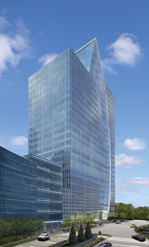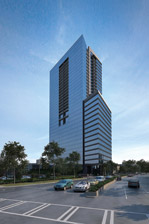|
COVER STORY, DECEMBER 2008
SOUTHEAST OUTLOOK 2009
Jon Ross
As the commercial real estate industry ends another year and heads into the next, Southeast Real Estate Business continues its tradition of looking back on performances of certain property types in different regions of the Southeast in 2008 and what to expect for those markets in 2009. In this issue, retail markets from major cities around the region are covered. In Charleston, S.C., tenant expansion, once a hallmark of the city’s market, has slowed. Baltimore, Savannah, Ga., and Charlotte, N.C., are also feeling the credit crunch in their retail sectors. The Louisville, Kent., office sector is tied to uncertainty in the auto industry, and Nashville, Tenn., office space is relatively healthy compared to other cities. Pick up next month’s Southeast Real Estate Business to read industrial outlooks for Birmingham, Ala., Miami and other cities as well as multifamily reports on major cities including Raleigh, N.C., and Atlanta.
OFFICE OUTLOOK
Atlanta
 |
Atlanta’s Two Alliance Center
|
|
In 2009, office space will rule Atlanta’s Buckhead neighborhood. Three Class A office buildings — Two Alliance Center, 3630 Peachtree and Terminus 200 — will deliver 1.5 million square feet of space to the market next year, creating abundant opportunity for new users.
“The significant amount of new space being delivered to the urban markets at a time when job creation has slowed is the biggest single factor affecting the market next year,” says John Fetz, senior managing director of tenant representation at Jones Lang LaSalle’s Atlanta office. “This will create a significantly favorable market for tenants.”
The new space will come online at a time when the commercial real estate market citywide is trying to rebound from the pervasive economic slowdown. In the last quarter of 2008, instead of leasing up office space as it became available, tenants chose instead to wait to see how and if the market would rebound from the economic collapse before signing any deals. In that quarter, vacancy rates in Atlanta stood at 19 percent, and sublease space was on the rise, Fetz says. Even with landlords more likely to offer concessions, the state of Atlanta’s office market won’t change drastically for at least 6 months.
 |
Atlanta’s 3630 Peachtree.
|
|
“Leasing activity will probably not increase significantly until mid-2009, and market conditions will continue to soften,” he says. “However, since Atlanta is a diverse market and our fundamentals are strong, the city tends to bounce back quickly from downturns.”
Charlotte
Office projects hoping to get off the ground next year in Charlotte may have some hurdles to overcome. Though the market boasts a relatively stable vacancy rate in the 11 to 12 percent range, companies are cautious about signing to new developments.
“Recent months have been marked by a steep decline in tenant activity,” says Tim Bahr of Charlotte-based NAI Southern Real Estate. “Consequently, a number of proposed projects are facing a big challenge in securing adequate pre-lease commitments.”
Even with hesitant tenants, the market will see four developments establish themselves in the next year. The central business district will welcome 440 S. Chruch St., a 363,000-square-foot Class A building in the third quarter of next year, and the NASCAR Plaza will open up 393,730 square feet of space near the NASCAR Hall of Fame in March. When completed, Ballantyne Corporate Park will encompass 800,000 square feet of office space, and 270,000 square feet of the 750,000-square-foot 1 Bank of America Center is aimed at office users. All this new space on the market comes hand-in-hand with lingering questions surrounding the major Charlotte institution Wachovia, creating uncertainty in the market.
“The Charlotte office market will stumble through 2009,” Bahr says. “The CBD will soften with the delivery of significant new product, coupled by a potential consolidation by Wachovia and Wells Fargo. That said, the increase in available inventory shouldn’t create an Armageddon atmosphere.”
Birmingham
During the last few years, the Birmingham office market has seen increasing rental rates and ballooning costs. This has led to a slowdown in new construction. The vacancy rate, however, has stayed low.
“The market has been beneficial to the existing building owners,” says Philip A. Currie of Birmingham-based J.H. Berry & Gilbert. “Most of the owners in town are paying attention to their existing tenants. General market activity has slowed in the past 24 months.”
Curie thinks that the Birmingham office market is not as volatile as others around the country. The financial sector plays a huge role in the market, and until things settle down, business will fluctuate more than usual.
“Birmingham is historically not susceptible to large ups and downs,” he says. “2009 will see more lease renewals than new tenant growth and existing tenant growth as people eye the national economy.”
To try to revive the office sector, Colonial Properties Trust is set to deliver 140,000 square feet of its Colonial TownPark Colonnade site on Highway 280 in the next year. Also slated for development is 50,000 square feet of office space at The Summit Birmingham by Bayer Properties.
But the financial markets ultimately have the final say in any of the office sector’s recovery plans.
“Birmingham’s economy is driven in large part by healthcare and banking,” Currie says. “The market will be paying very close attention to the financial sector.”
Washington, D.C.
 |
The National Gateway projects will bring more than 400,000 square feet to the Washington, D.C. office market next year.
|
|
Stagnant is the word Ryan Nunes of Studley uses to describe Washington’s office market. Rental rates in 2008 are down slightly and new development in the region is at a standstill. Nunes says that only more than a quarter of the office space under construction is preleased.
“If the credit markets unfreeze, we will see more confident investors,” he says. “As businesses start to benefit from a stabilized economy, we should see leasing activity regain its momentum. Some tenants will begin vacating existing space in favor of more cost-effective solutions, while others may look to upgrade their space with a flight to quality.”
There are still quite a few significant office properties coming into the market in 2009, proving that even though Washington is hurting, it’s still better off than most markets. In the Crystal City submarket, the 409,744-square-foot National Gateway I and II will deliver. The office space will eventually total 1.5 million square feet and be joined by 185,000 square feet of retail space. The 507,000-square-foot phase three of Station Place will deliver in October, and Two and Three Patriots Plaza, a 705,000-square-foot development, are slated for September. Finally, renovations underway include upgrades to the 605,000-square-foot Victory Center in Alexandria and the more than 1.4 million-square-foot Constitution Center.
With these new projects on the board, tenants will have an easier time finding space in the market. For at least some of next year, tenants will rule the Washington office arena.
“Availability rates are expected to continue to rise next year in the Maryland and Virginia submarkets outside the beltway, mostly as a result of newly delivered, vacant space,” Nunes says. “The D.C. region can also expect to see an increase in early lease restructures, as tenants leverage current market conditions to lock in a lower rental rates.”
Nashville
Historically, the vacancy rate of Nashville’s office market has hovered around 10 percent. This, says Whit McCrary of Colliers Turley Martin Tucker, is a healthy rate. Currently, the office vacancy rate sits at 11.5 percent. This number should stand up fairly well in the coming year because of Nashville’s insulation from the region’s flights of economic whimsy.
“The area’s diversified economy cushions against highs and lows, with healthcare, music, publishing, automotive and insurance companies propping up the office market,” McCrary says.
 |
One Greenway Centre in Nashville.
|
|
In 2009, Crescent Resources will deliver One Greenway Centre, a 155,000-square-foot, LEED-certified Class A office building, to the area. Southern Land will also do its part to create new office space, completing the 145,000-square-foot McEwen Building. Together, the two developments represent a 6 percent increase in the market’s supply of office product. Another factor to keep an eye on is the healthcare sector, which is a huge part of the Nashville office market.
“The healthcare industry is one of Nashville’s top demand drivers of space,” McCrary says. “Healthcare policies put in place by the newly elected federal administration could negatively affect the industry reducing the overall demand for office space.”
Due to the low vacancy rate and the resilience of Nashville’s office tenants, McCrary sees no reason to worry coming into next year.
“Nashville has faired better than most markets during this economic downturn and should continue to do so in 2009,” he says. “Delivery of new product will taper off so absorption will not have to be as strong as 2008 to maintain a healthy vacancy rate. Rental rates will likely remain stable in 2009.”
Louisville
The Louisville office market is tied to the auto industry. With uncertainty surrounding job losses and federal bailout packages, office brokers in Louisville don’t feel like they can make predictions for next year. One thing is certain: activity in the Louisville office market has dried up until at least the second quarter of 2009, says Brian Forrest of Louisville-based Hoagland Commercial Realtors.
“No one knows what is going to happen,” he says. “Louisville has two Ford plants. [Plant closings] could have a ripple effect for the entire city.”
Two small benefits can be seen through the credit crunch’s haze. Developers have been hesitant to build office product in the city, so the market isn’t saturated with vacant space. Additionally, construction prices have fallen drastically.
“New projects are stopped until the climate improves,” Forrest says.
The further ripple of a new administration, and the inevitable changes in policy that come with it, has tenants waiting to see what will happen to the financial climate. Forrest says he’s reluctant to make sweeping predictions about the market because of these factors.
“Tenants will be looking to cut costs and landlords will have to offer concessions to keep some larger tenants,” he says, providing a bit of hope for next year. “It might take twice as long to get deals done, but I think ultimately they will be available.”
RETAIL OUTLOOK
Charlotte
Retail in Charlotte is locked in a vicious cycle. Retailers have stopped expanding — the only projects slated for 2009 are those that were planned before the economic slowdown — and this lack of activity is making consumers worry about the strength of the economy. Consumers worried about the state of the economy, in turn, keep the market from regaining ground.
“People’s attitude has a lot to do with our current slow down. Things are not as bad as some might think,” says Jim Plyler of Charlotte-based Piedmont Properties/CORFAC International. “Some retailers are reporting slower sales, with up to a 20 percent drop in sales, while others are seeing a slight downturn. A lot of shoppers hear all of the negative talk about the economy, so they keep their pocketbooks closed. A little bit of good economic news could help the retailers with more shoppers.”
Plyler predicts that tenants that are turning a dwindling profit are likely to close locations throughout the city. This means vacancy rates in Charlotte will increase, but mostly in the secondary markets; stronger, more profitable stores will weather the downturn adequately. Even with this forecast, Plyler sees hope for the coming year. He says that a drop in mortgage rates, combined with the current downward spiral of oil prices, will give consumers the confidence needed to realign Charlotte’s struggling retail market.
“All of the negative attitude keeps people feeling negative about the economy,” he says. “I think 2009 should be a fairly good year.”
Charleston
Before the economic mess hit, Charleston retail had been performing extremely well. Commercial transactions were being completed, and consumers were spending money. Tenants and landlords were happy.
“The market’s currently still healthy,” says Erin England, a principal at Colliers Keenan in Charleston, “we just have a little bit less volume going than we did. We were at a pretty high mark before; we were getting things done at a fast clip. That type of velocity in the market can’t be expected in perpetuity.”
While Charleston may be somewhat immune to many of the problems facing other markets in the Southeast, England is starting to see signs of a slowdown. It’s also early enough in the game that it’s hard for him to predict how painful the downturn will be. But for now, tenants in Charleston aren’t panicking.
“I haven’t seen any fireselling of property yet,” he says. “The interesting thing to see will be when this next cycle of notes come up for maturity — has there been enough growth in equity to prevent the owner from having to put a lot more equity into the deal just to refinance. That’s the next sequence we need to pay attention to.”
With all this uncertainly surrounding his healthy market, England is waiting for numbers from the holiday season. Measuring consumer spending will help him get a handle on how long the downturn will last.
“The markets will rebound when the economy and consumer confidence returns,” he says. “It can’t help but translate into consumer spending, which will bring these retailers back to profitability and stability. Right now it’s anybody’s guess what’s going on with the economy.”
Savannah
Before the credit crunch, retailers were flooding Savannah with multiple store openings. Now, these same retailers are focusing on smaller, simpler openings in the area.
“Many national retailers have put expansion plans on hold for 2009,” says Anthony Wagner of Savannah-based Melaver Mouchet. “Those still expanding have cut their numbers for new stores planned. Others have announced closings some of which affecting the Savannah area.”
While retailers are no longer clamoring to establish themselves in Savannah, there are a few significant retail projects coming online next year. The second phase of the 200,000-square-foot Abercorn Common will deliver 14,000 square feet of retail space next summer. Two Food Lion-anchored shopping centers will open next year, including Garden City, which is located near the intersection of Interstates 16 and 95. Smaller retail developments include a 5,000-square-foot IHOP and a 3,000-square-foot Verizon Wireless Store, both located on Truman Parkway.
The new year will also bring a marked increase in distressed property transactions, Wagner says. “As borrowers have their short-term financing come due and are unable to replace it with new debt,” he says, “there will be a number of institutions sitting on the side lines with cash in hand ready to swoop in and make purchases at discounted rates.”
All in all, it will be a slow 2009 for the Savannah retail market. Retail sales will be sluggish and new development activity will be minimal. But due to economic and demographic factors, Savannah may be better equipped for the next year than other cities.
“Savannah has a tendency to weather economic downturns slightly better than other major markets and is doing so with the current economic situation as well.”
Baltimore
Geoff Mackler, a principle at Baltimore-based H&R Retail, may have a sunnier disposition than some. When asked about the Baltimore retail market, he’s full of optimism.
“A number of tenants that still have cash are expanding, both locally and nationally,” he says. “Because of our proximity to D.C., we’re still seeing a lot of action out there.”
Even with an active current market, the Baltimore retail sector is still bracing for a slowdown. For many tenants, financing is still difficult to find. When a number of other factors enter the mix, it’s hard for Mackler to make a prediction as to when Baltimore’s retail market will come back full steam.
“Everyone is feeling poor. Whether it’s real or not, it certainly is on paper,” Mackler says. “People are losing jobs. We’ve finally at least gotten some clarity as far as who our next president is going to be, but we don’t know where jobs are, we don’t know where interest rates are going to be, we don’t know where access to capital is going to be.”
Mackler says that the projects slated for next year are mostly redevelopments. Aside from tenant activity at McHenry Row in the Locust Point neighborhood in Baltimore and ground-floor retail at Four Seasons in Inner Harbor East, Mackler doesn’t see much to talk about.
“Retailers are bankrupt, and the world of tenants continues to shrink,” he says. “There’s opportunity if you have cash and can be creative. Whenever there’s fewer players in the marketplace, there tends to be an opportunity for people to pick something up, whether it is better customer service or a larger breadth of product line.”
©2008 France Publications, Inc. Duplication
or reproduction of this article not permitted without authorization
from France Publications, Inc. For information on reprints
of this article contact Barbara
Sherer at (630) 554-6054.
|
